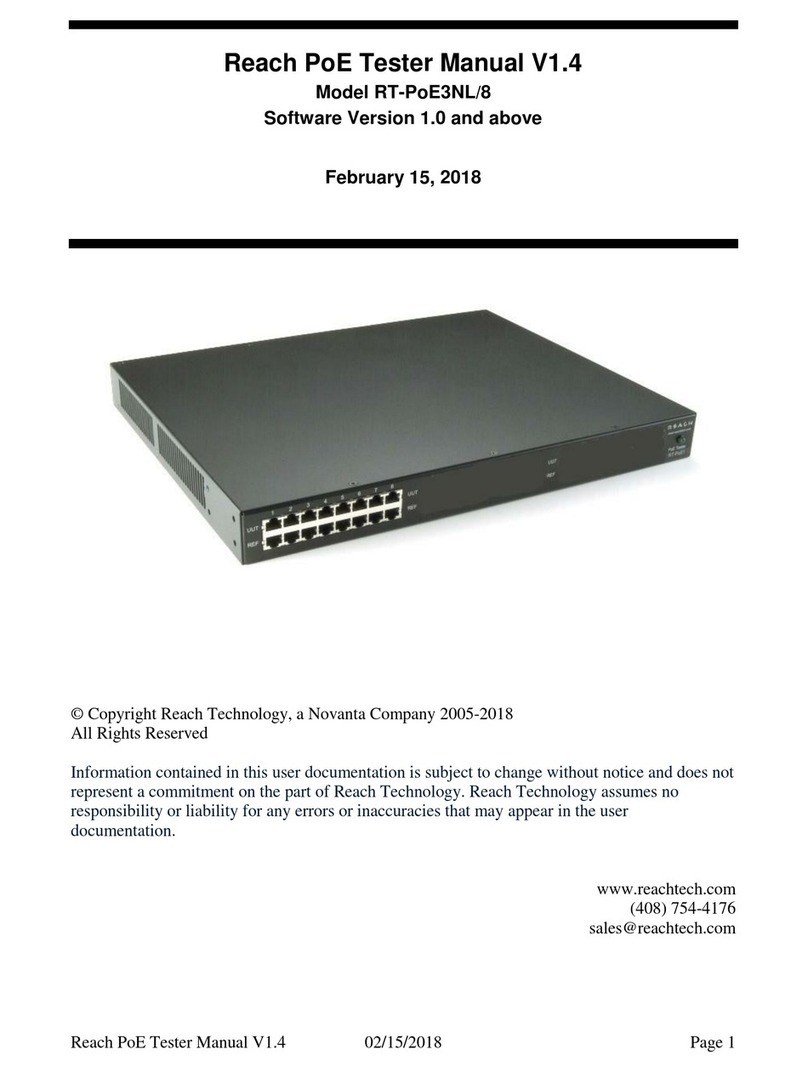Reach PoE5 Tester Manual 1.8 03/25/2021 Page 2
Table of Contents
1. REVISION HISTORY........................................................................................................... 4
1.1. RT-POE5 -BASE MODEL .................................................................................................. 4
1.2. RT-POE5 VARIATIONS...................................................................................................... 4
2. GENERAL.............................................................................................................................. 5
2.1. OVERVIEW......................................................................................................................... 5
2.2. FRONT PANEL.................................................................................................................... 5
2.3. FEATURES.......................................................................................................................... 6
2.4. DIMENSIONS...................................................................................................................... 6
2.5. ELECTRICAL CHARACTERISTICS....................................................................................... 6
2.6. ENVIRONMENTAL.............................................................................................................. 6
2.7. WARRANTY....................................................................................................................... 6
2.8. OPERATING SOFTWARE..................................................................................................... 6
2.9. CALIBRATION.................................................................................................................... 7
3. CONFIGURATION GUIDE................................................................................................. 8
3.1. POWER............................................................................................................................... 8
3.2. SERIAL CONSOLE .............................................................................................................. 8
3.3. UUT CONNECTIONS.......................................................................................................... 9
4. CONNECTORS AND JUMPERS...................................................................................... 10
4.1. RJ-45 ETHERNET CONNECTORS...................................................................................... 10
4.2. REAR CONNECTORS ........................................................................................................ 10
4.3. ETHERNET POWER SELECTION........................................................................................ 11
5. OPERATIONAL OVERVIEW .......................................................................................... 12
5.1. DATA PATH...................................................................................................................... 12
5.2. POWER INPUT .................................................................................................................. 13
5.3. SIGNATURE,CLASS,AND LOAD....................................................................................... 14
5.4. DUAL/SINGLE SIGNATURE MODES ................................................................................. 15
5.5. FANS................................................................................................................................ 16
5.6. RJ45 LEDS...................................................................................................................... 16
6. ETHERNET CABLES......................................................................................................... 17
7. COMMAND REFERENCE................................................................................................ 18
EEPROM WARNING.................................................................................................................. 18
ECHO ........................................................................................................................................ 19
ERROR CHECK........................................................................................................................ 19
HELP ......................................................................................................................................... 19
VERSION.................................................................................................................................. 19
BAUD........................................................................................................................................ 20
BOOT ........................................................................................................................................ 20
HOSTNAME............................................................................................................................. 20
SHOW ALL............................................................................................................................... 21
CLEAR...................................................................................................................................... 21
LOAD........................................................................................................................................ 21
SAVE......................................................................................................................................... 22
PORT /GROUP PREFIX .......................................................................................................... 22





























